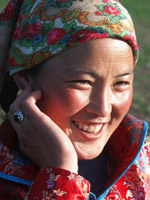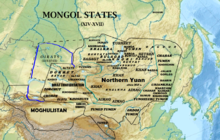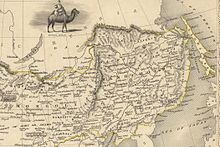Daur people
ᡩᠠᡤᡠᠷ | |
|---|---|
 Daur woman in Inner Mongolia, (China) | |
| Total population | |
| c. 131,393 (2010 census)[1] | |
| Regions with significant populations | |
| People's Republic of China, in Inner Mongolia, Heilongjiang and Xinjiang. | |
| China | 131,393[2] |
| Mongolia | 3,000[3] |
| Languages | |
| Daur, Chinese, Mongol | |
| Religion | |
| Mongolian shamanism and Tibetan Buddhism | |
| Related ethnic groups | |
| Buryats, Mongols and Khitan | |
The Daur people, Dagur, Daghur or Dahur (
Language
The Dagur language is a Mongolic language. There is a Latin-based orthography which has been devised by a native Daur scholar. The Dagur language retains some
During Qing rule, some Daur spoke and wrote Manchu as a second language.[4]
History



Genetically, the Daurs are descendants of the Khitan, as recent DNA analyses have proven.[5] In the Qianlong Emperor's "钦定《辽金元三史语解》" (Imperially commissioned Translations of the History of Liao, History of Jin and History of Yuan) he retranslates "大贺", a Khitan clan described in the History of Liao, as "达呼尔". That is the earliest theory that claims Daurs are descendants of Khitans.
In the 17th century, some or all of the Daurs lived along the
By the mid-17th century, the Amur Daurs fell under the influence of the Manchus of the
Cattle and horses in the hundreds were looted and 243 ethnic Daur girls and women were
Facing the Russian expansion in the Amur region, between 1654 and 1656, during the reign of Shunzhi Emperor, the Daurs were forced to move southward and settle on the banks of the Nen River, from where they were constantly conscripted to serve in the banner system of the Qing emperors.
Russian Cossack soldiers slaughtered 1,266 households, 900 Daurs during the
When the Japanese invaded the area of present-day Morin Dawa in Inner Mongolia in 1931, the Daurs carried out an intense resistance against them.[9]
Culture
There is a very noticeable hierarchic structure. People sharing the same surname are in groups called hala, they live together with the same group, formed by two or three towns. Each hala is divided in diverse clans (mokon) that live in the same town. If a marriage between different clans is made, the husband continues to live with the clan of his wife without holding property rights.
During the winter, the Daur women wear long dresses, generally blue in color and boots of skin which they change for long trousers in summer. The men dress in orejeros caps in fox or red deer skin made for winter. In the summer, they cover the animal's head with white colored fabrics or straw hats.
A customary sport of the Daur is Beikou, a game similar to field hockey or street hockey, which has been played by the Daur for about 1,000 years.[11]
Religion
Many Daurs practice shamanism. Each clan has its own shaman in charge of all the important ceremonies in the lives of the Daur.[12] However, there are a significant number of Daurs who have taken up Tibetan Buddhism.
During the Qing, the Daur knew a version of the Tale of the Nisan Shaman, in which the female shaman Ny Dan competed against her rivals at the Qing court, the Tibetan monks who managed to convince the Qing emperor to execute her. The Qing emperor is shown as a fool who is tricked by the lamas.[13]
Notes
- ^ Multicultural China: A Statistical Yearbook (2014), p349
- ^ "China's Dagur Minority: Society, Shamanism, and Folklore" (PDF). Retrieved 2018-04-20.
- ^ "Монгол овог аймгууд". Retrieved 2021-11-15.
- ISBN 978-0-520-92679-0.
- ^ Li Jinhui (2 August 2001). "DNA Match Solves Ancient Mystery". china.org.cn.
- ^ a b Вадим Тураев (Vadim Turayev), О ХАРАКТЕРЕ КУПЮР В ПУБЛИКАЦИЯХ ДОКУМЕНТОВ РУССКИХ ЗЕМЛЕПРОХОДЦЕВ XVII Archived 2004-12-30 at archive.today ("Regarding the omissions in published documents of Russian 17th-century explorers") (in Russian)
- ISBN 978-0143109891.
- ^ 俄罗斯帝国总参谋部. 《亚洲地理、地形和统计材料汇编》. 俄罗斯帝国: 圣彼得堡. 1886年: 第三十一卷·第185页 (俄语).
- ^ Bulag, Uradyn E. The Mongols at China's edge: history and the politics of national unity. Rowman & Littlefield Publishers, 2002. p.158
- ISBN 978-4000029032.
- ^ McGrath, Charles (August 22, 2008). "A Chinese Hinterland, Fertile With Field Hockey". The New York Times. Retrieved 2008-08-23.
- ^ Humphrey, Caroline; Onon, Urgunge (1996). Shamans and Elders: Experience, Knowledge, and Power among the Daur Mongols. Oxford: Clarendon Press.
- ISBN 978-0-520-22837-5.
External links
- Unicode Manchu/Sibe/Daur Fonts and Keyboards
- The Daur ethnic minority (Chinese government site, in English)
